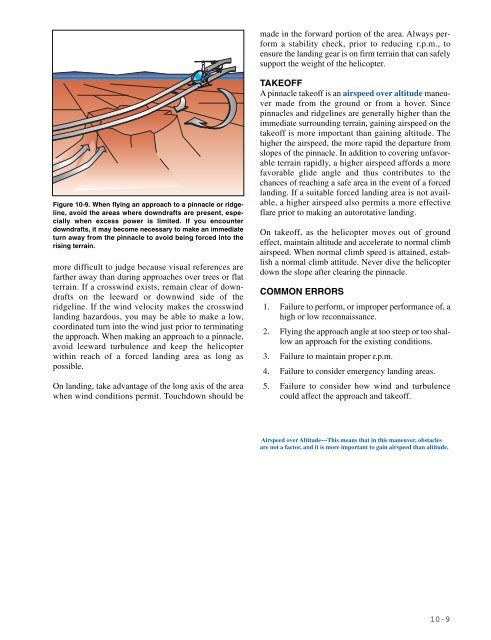Rotorcraft Flying Handbook, FAA-H-8083-21
Rotorcraft Flying Handbook, FAA-H-8083-21
Rotorcraft Flying Handbook, FAA-H-8083-21
Create successful ePaper yourself
Turn your PDF publications into a flip-book with our unique Google optimized e-Paper software.
made in the forward portion of the area. Always perform<br />
a stability check, prior to reducing r.p.m., to<br />
ensure the landing gear is on firm terrain that can safely<br />
support the weight of the helicopter.<br />
Figure 10-9. When flying an approach to a pinnacle or ridgeline,<br />
avoid the areas where downdrafts are present, especially<br />
when excess power is limited. If you encounter<br />
downdrafts, it may become necessary to make an immediate<br />
turn away from the pinnacle to avoid being forced into the<br />
rising terrain.<br />
more difficult to judge because visual references are<br />
farther away than during approaches over trees or flat<br />
terrain. If a crosswind exists, remain clear of downdrafts<br />
on the leeward or downwind side of the<br />
ridgeline. If the wind velocity makes the crosswind<br />
landing hazardous, you may be able to make a low,<br />
coordinated turn into the wind just prior to terminating<br />
the approach. When making an approach to a pinnacle,<br />
avoid leeward turbulence and keep the helicopter<br />
within reach of a forced landing area as long as<br />
possible.<br />
On landing, take advantage of the long axis of the area<br />
when wind conditions permit. Touchdown should be<br />
TAKEOFF<br />
A pinnacle takeoff is an airspeed over altitude maneuver<br />
made from the ground or from a hover. Since<br />
pinnacles and ridgelines are generally higher than the<br />
immediate surrounding terrain, gaining airspeed on the<br />
takeoff is more important than gaining altitude. The<br />
higher the airspeed, the more rapid the departure from<br />
slopes of the pinnacle. In addition to covering unfavorable<br />
terrain rapidly, a higher airspeed affords a more<br />
favorable glide angle and thus contributes to the<br />
chances of reaching a safe area in the event of a forced<br />
landing. If a suitable forced landing area is not available,<br />
a higher airspeed also permits a more effective<br />
flare prior to making an autorotative landing.<br />
On takeoff, as the helicopter moves out of ground<br />
effect, maintain altitude and accelerate to normal climb<br />
airspeed. When normal climb speed is attained, establish<br />
a normal climb attitude. Never dive the helicopter<br />
down the slope after clearing the pinnacle.<br />
COMMON ERRORS<br />
1. Failure to perform, or improper performance of, a<br />
high or low reconnaissance.<br />
2. <strong>Flying</strong> the approach angle at too steep or too shallow<br />
an approach for the existing conditions.<br />
3. Failure to maintain proper r.p.m.<br />
4. Failure to consider emergency landing areas.<br />
5. Failure to consider how wind and turbulence<br />
could affect the approach and takeoff.<br />
Airspeed over Altitude—This means that in this maneuver, obstacles<br />
are not a factor, and it is more important to gain airspeed than altitude.<br />
10-9

















